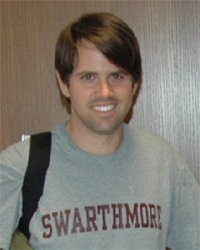Guy Haskin Fernald '94

Biomathematics Researcher
UC San Francisco
and former internet entrepreneur
"Attention Shoppers: Internet Is Open" read the August 12, 1994 headline of the New York Times article featuring the company I co-founded while still a senior at Swarthmore. On August 11th we had made Internet history by receiving the first securely encrypted credit card transaction from a web browser for the purchase of the compact disc "Ten Summoners' Tales" by Sting. The charge was for just $12.48 plus shipping, but it was the beginning of a commerce system that has outgrown nearly all expectations. During my senior year at Swarthmore, I had spent many weekends in New Hampshire, writing software to create commerce websites for the then nascent World Wide Web. The success of the Web and of our company launched me into an extended sojourn through Internet entrepreneurism that took me from eating ramen out of a crock pot to dining at the finest restaurants in Silicon Valley. What was originally planned as a brief exploration before graduate school swept me into many more exhilarating years working in Internet software.
Our company was called NetMarket and was started by four college graduates, three of whom were from Swarthmore. In the next year we grew NetMarket to nearly thirty people and created Internet storefronts for CD companies, electronics stores, flower shops, and several other companies. We ultimately sold the company and within two years I returned to my native California where I entered the center of the now energized world Internet software startups. My next company I joined was called Ariba, where I was a member the original engineering team creating the first wave of multi-tiered business applications for the web. The company was a huge success and we grew it from a dozen people to a publicly traded company with more than 1,500 employees over the next four years. They were four incredible years, full of long hours of programming, traveling to businesses and conferences, and recruiting and managing many new talented programmers.
After a time I decided to take a sabbatical from Internet software to reconsider other career possibilities. I moved with my wife to Mexico and worked as a computer consultant for the National Institute of Health and began to explore the new ways in which mathematics and technology were being applied to facilitate and contribute to social, medical, and biological research. When we returned to California I took courses in chemistry, biology, and bioinformatics and took a position as a Research Associate at the University of California, San Francisco (UCSF).
I have now been working at UCSF for two years, and I have had the opportunity to author papers, present at conferences, and collaborate with other researchers at UCSF and other universities. The application of mathematics to biology has been fascinating. I have applied statistics to analyze large biological datasets, game theory to create agent-based simulations of biological activity, and information theory to create networks of genetic information based on calculations of entropy. The result has been an exciting combination of mathematics, computation, and biology. I am now pursuing this interest further by returning to my original post-graduation plans to go to graduate school so that I may continue to engage in and refine my research goals and interests


